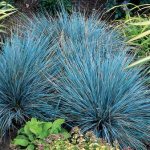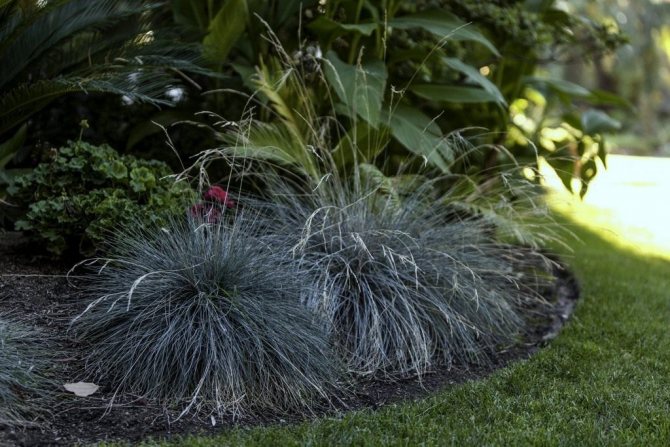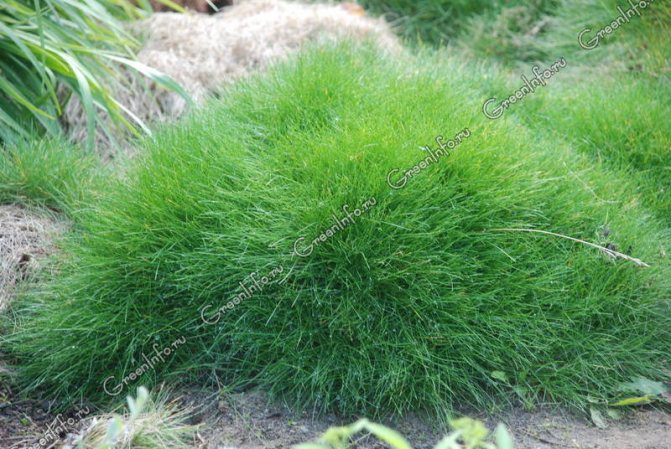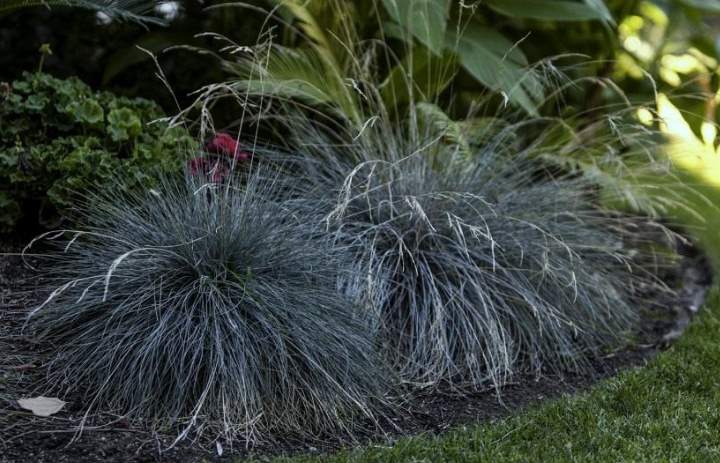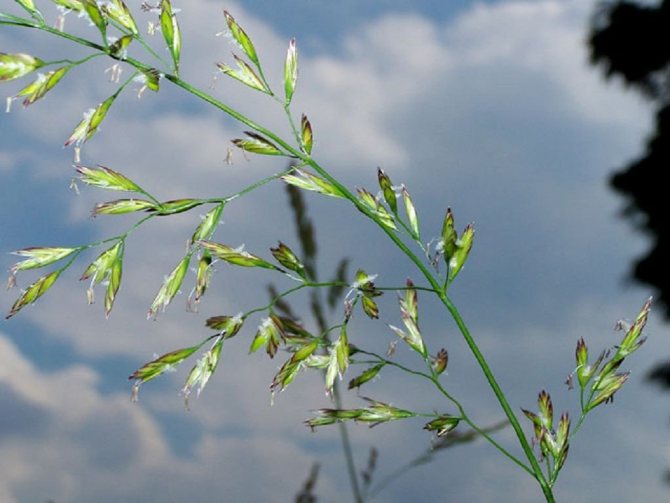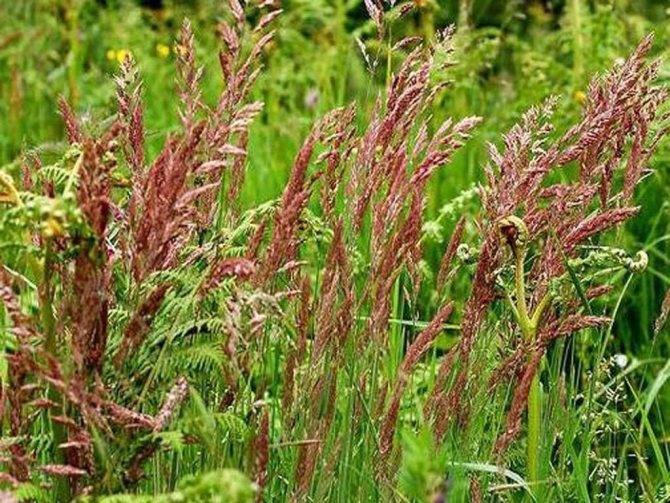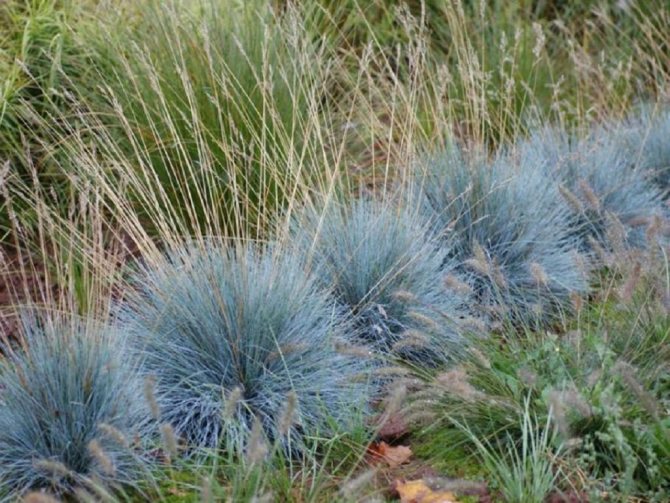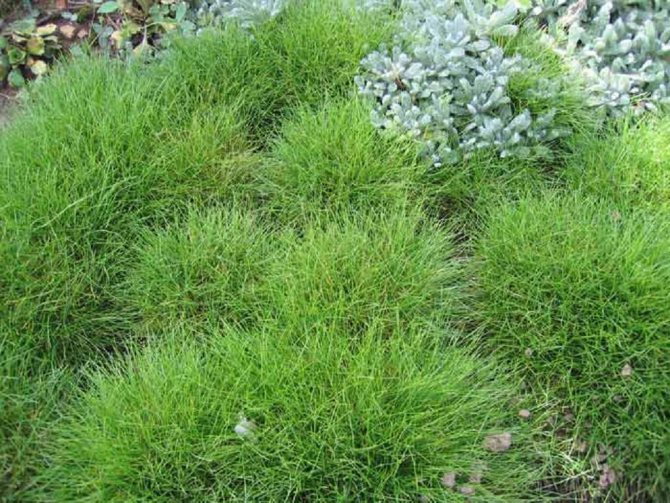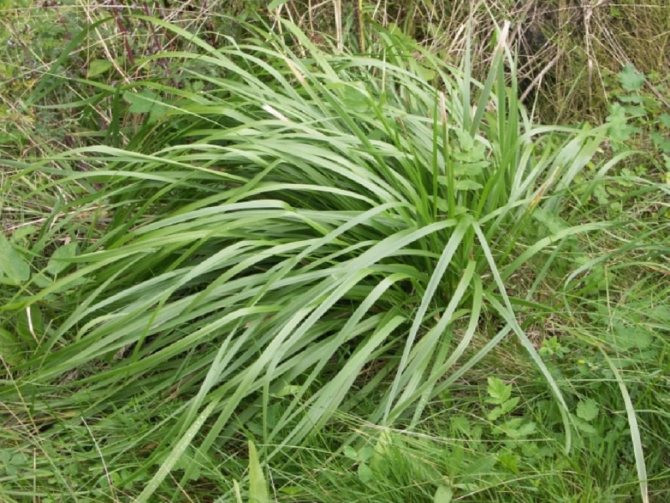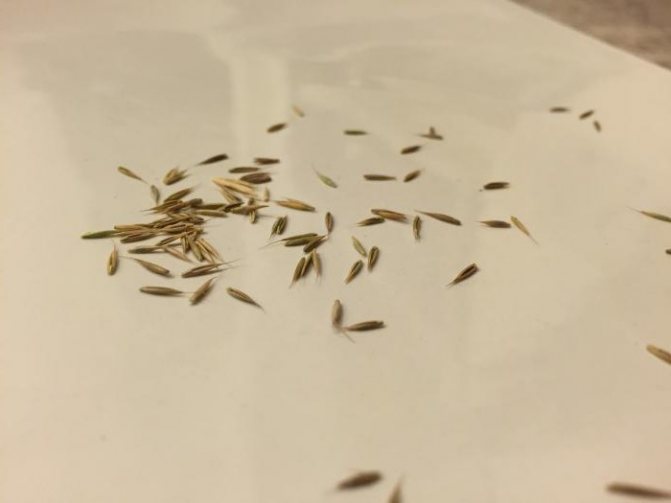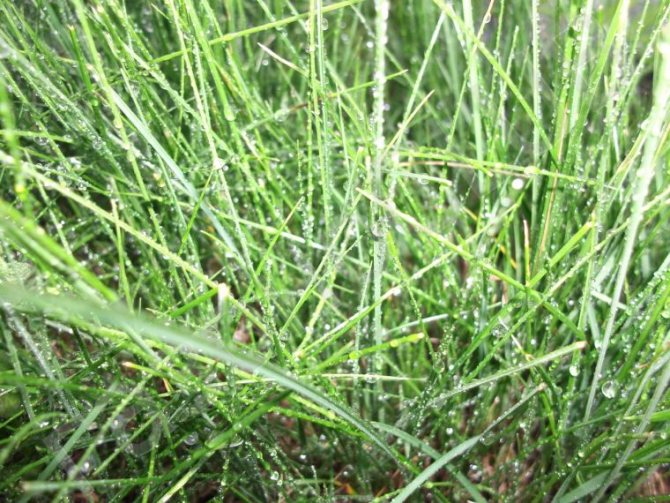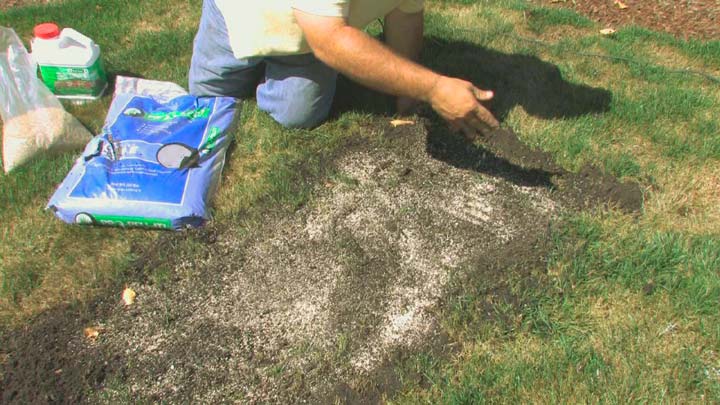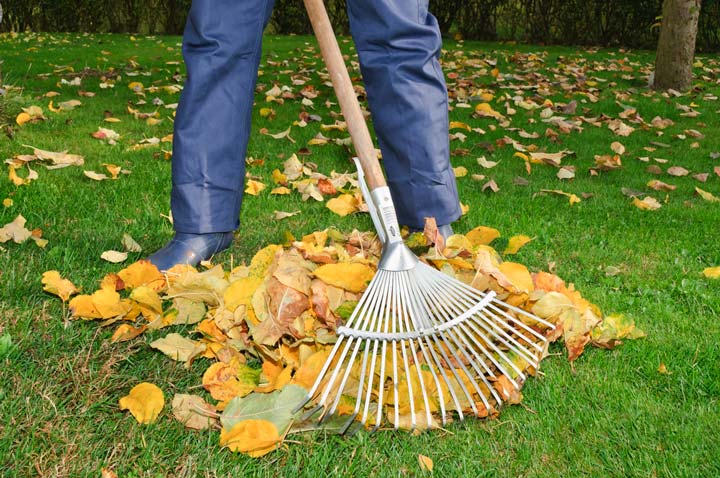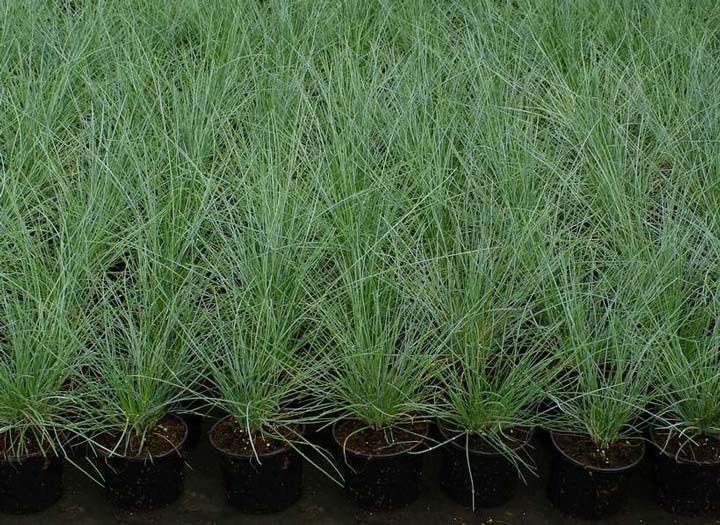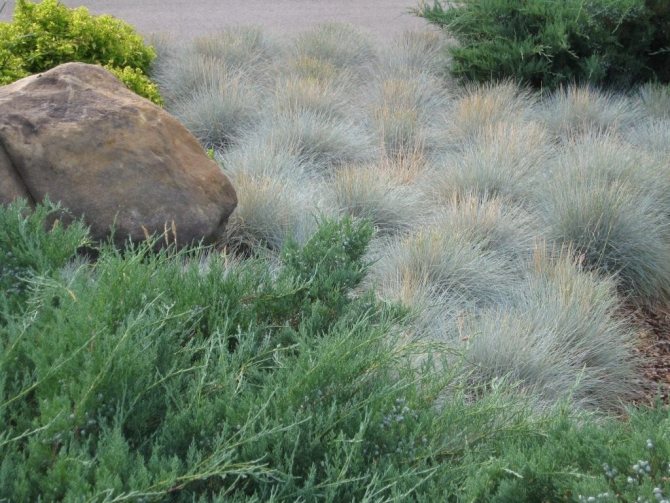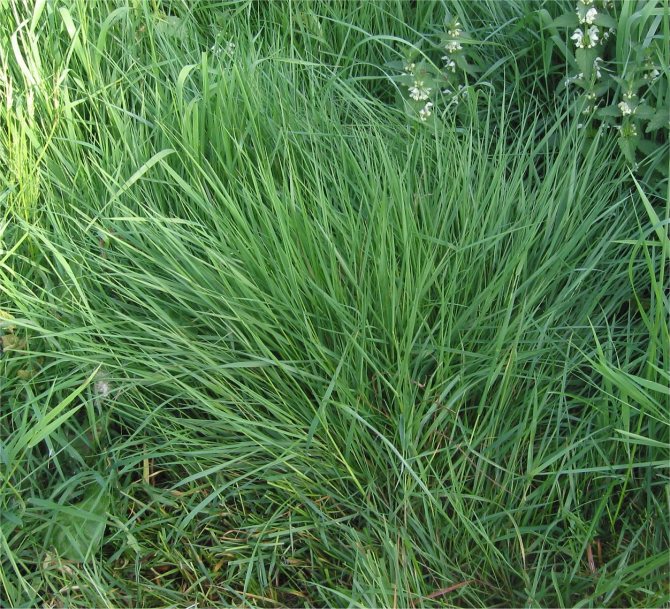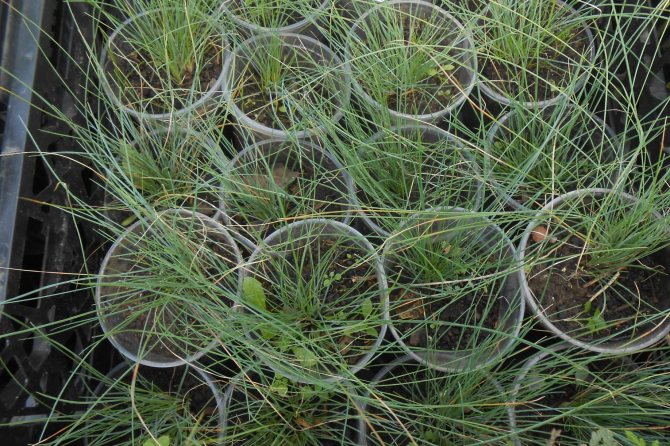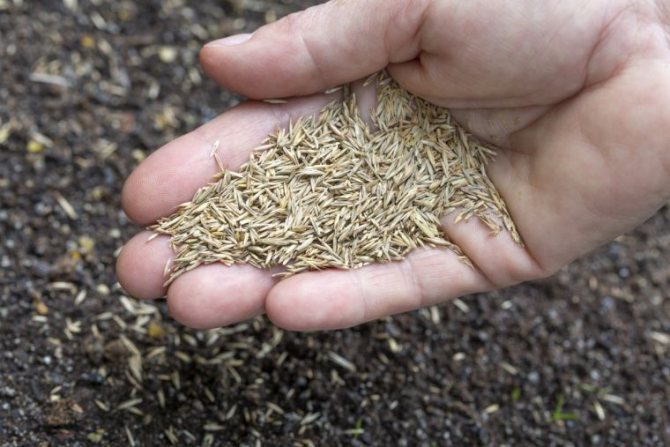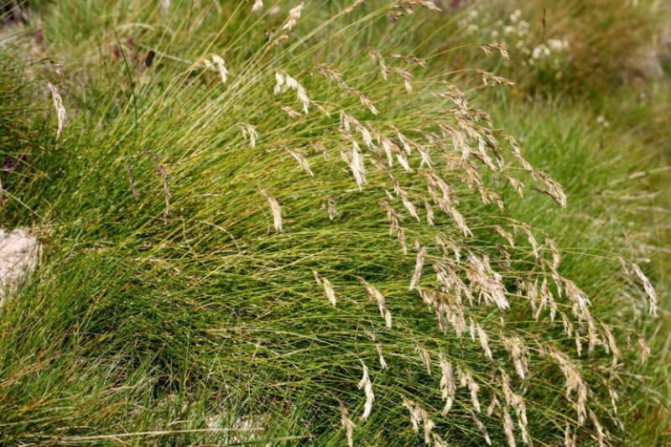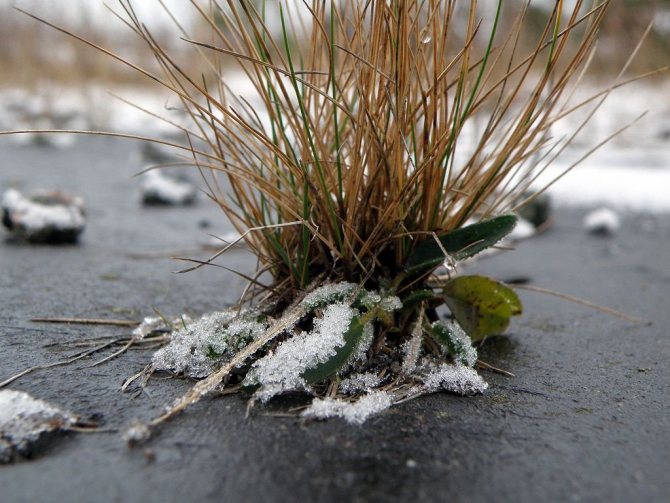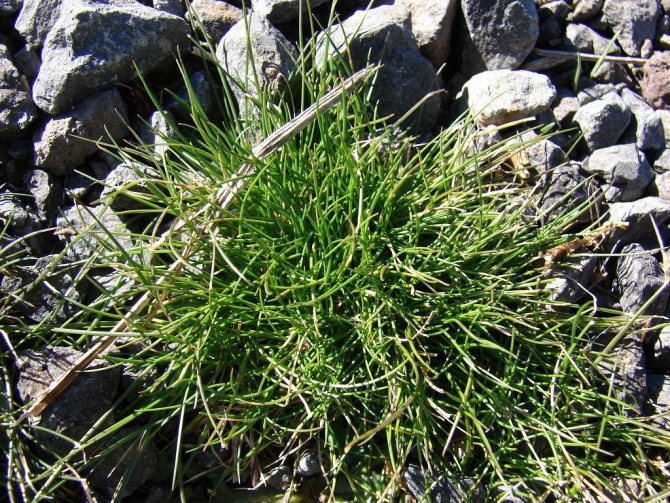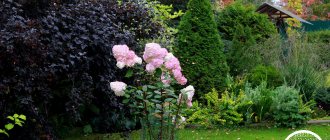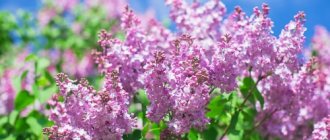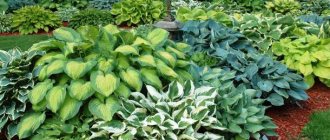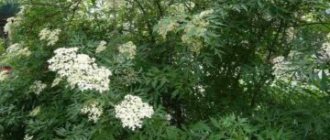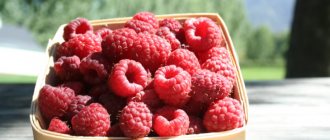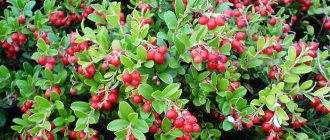Gray fescue is an unusual and rather amazing plant with a large size and a spherical crown. The advantage of undersized bushes lies in their irregular shape and attractive leaf color, which differs from the rest of the plants used in landscape design.
In addition, many designers appreciate this cereal for its endurance and unpretentiousness, which allows it to be used in the design of many landscape compositions or flower beds in the garden.
Gray fescue
Description of the plant fescue (with photo)
Starting the description of the plant fescue (Festuca), it is worth noting that it is a genus of herbaceous plants of the family Cereals (Gramineae)
The genus Fescue combines several types: red fescue; sheep; gigantic; meadow, etc. All these species have a great similarity in the structure of shoots, inflorescences, flowers. Differences are manifested in the coloration of the spikelet scales and in the presence or absence of awns on the lower floral scales.
The photos of the fescue plant presented below illustrate its unusual and at the same time attractive appearance:
The scientific name of the genus Fescue - Festuca - comes from the Celtic word fest, which means "food". This word was used to evaluate the good feeding qualities of plants of this genus.
See how the fescue looks in the photo and the description of the cereal will become clearer for presentation:
Use in landscape design
A lush mop of narrow leaves of a blue, green, gray or light green shade looks good on the lawn, among stony masonry, at the curb or along the perimeter of the flower garden. Fescue roots effectively strengthen the soil and prevent landslides. On the slopes, you can create an unusual panel of bushes of various shades.
Bells, cuffs, hosts, tradescantia, veronica, miscanthus, lungwort can make a company for fescue. Also, plants can be used as a regular lawn, not planting in groups, but more evenly.
What does sheep fescue look like (description with photo)
Let's start the description sheep's fescue (Festuca ovina L.) because it is a perennial plant. To imagine what sheep's fescue looks like, it is worthwhile to understand that this is a grass-root loose grass with a fibrous root system. The plant is 30-60 cm tall, stems are straight, smooth. Leaves are basal, bristle-like or thin-awl-like, mostly green, not bluish, rounded in cross section, without grooves on the sides. Tongue with ears. The inflorescence is a panicle. Spikelets are multi-flowered, lanceolate. Spikelet scales are sharp. The lower floral scales are pointed or with a short awn. The fruit is a weevil.
Sheep fescue is widespread in the forest and forest-steppe zones. In the forest zone, it occurs on absolute dry lands, especially on highly podzolic soils. In relation to water, it is a mesophyte. The plant is hygrophilous and grows well in more northern latitudes. The cereal is early ripening, starts to grow in early spring, blooms in late May - early June, the seeds ripen in the first half of July. A plant with a slow rate of development, it lasts up to 10 years in grass stands. Sheep fescue is used as a pasture plant, it endures strong butchery. It grows back quickly after bleeding. When pitted after flowering, the autumn aftermath does not form. Grain of high economic value.It has not been introduced into the culture.
See how sheep's fescue looks in the photo, where individual parts of the plant and the view as a whole are shown:
Planting recommendations
Mixes with bluegrass are well suited for arranging plots in regions located in the middle lane of the country. Meadow fescue for the lawn allows you to create a thick, bright green canvas from it, which tolerates drought and frost well.
The use of orchis medicinal in folk medicine
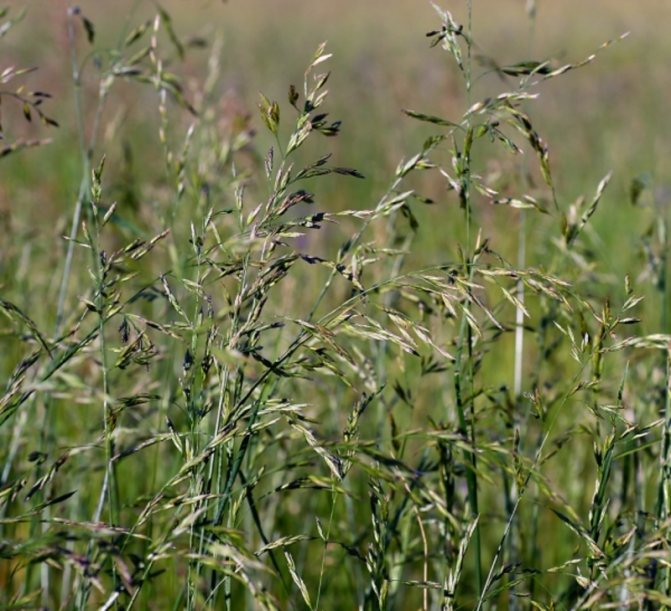
The plant grows quickly, is easy to care for and has high decorative qualities. But for the result to be worthy, you need to follow the rules of planting and care.
The area where the grass will be sown under the lawn should be regularly cleaned of debris. It can be removed manually, as well as by mulching, deep cultivation, and the soil can also be treated with herbicidal chemical components. As for the latter, the most effective tool is Roundup. It penetrates through the tissues to the root system of the grass. Weed residues are carefully collected with a rake.
The soil must be cultivated. The soil for the lawn must be dug to the depth of one shovel bayonet. With deep digging, you should carefully remove the roots, plant remains and stones, and also break up large lumps of earth, so that the soil will be homogeneous and loose. The surface is leveled with a rake, in the process it is necessary to align all the bumps, dimples and irregularities.
We must not forget about fertilizing the soil. For the herbal mixture to grow and develop better, the soil must have a neutral pH. If the soil is alkaline, then you need to add peat chips to it, if it has high acidity, then lime is better. To improve fertility, you can apply any organic fertilizers, for example:
- biohumus;
- compost;
- rotted manure.
If necessary, the topsoil is replaced with fertile soil or special lawn mixtures with minerals, sand and peat.
After cultivation and fertilization, the soil must be carefully leveled with a rake, then compacted with a round metal pipe or a garden roller. Instead of a skating rink, you can take a hermetically sealed barrel of water.
Before sowing, on the surface with a rake, make even 1.5 cm furrows along and across. Seeds are sown according to the consumption rates, which are indicated on the package. During sowing, you should look at the squares that need to be marked on the surface.
Mordovnik herb: medicinal properties and contraindications
At the end, the seeds are tamped with a rake, and then the soil is tamped with a roller. It is necessary to irrigate the grass by spraying.
Reed fescue (with photo)
Reed fescue (Festuca arundinacea Schreb.)
Perennial riding loose-shrub grass, up to 1.5 m high with a powerful root system, winter type of development. It has a thickened stem and many basal leaves. It differs from meadow fescue in the presence of awns on the lower floral scales and a large number of spikelets in the lower part of the panicle, in longevity (crops are used for 10–15 years). In spring, it quickly starts to grow and forms biomass earlier than other cereals. Moisture-loving and winter-hardy plant. It grows best with sufficient soil moisture and under irrigation conditions. However, it does not tolerate floodplains and estuaries. Introduced into culture and recognized in many countries around the world. In terms of yield, it surpasses all cultivated cereals.
The next is the reed fescue - the photo shows all the characteristic differences of the species:
Gardeners reviews
Mulled wine, Kiev
I recommend that you sow clean fescue - you will be pleasantly surprised. But you still need to feed her. Then maybe the old lawn will pleasantly surprise you.
Frezi Grant, Yekaterinburg
According to reviews, red fescue winters best. It will turn out without bald spots.
Furrowed fescue
Fescue furrowed fescue, fescue (Festuca valesiaca (Hask.) Gaudin).
Perennial. Low-density bush cereal, winter type of development. The root system is fibrous, it goes deep into the soil up to 80 cm. The height of plants averages 30–35 cm, 15–20 cm on salt licks, 40–50 cm on chernozems. Stems are numerous, straight and smooth. Forms a large number of basal leaves. There are few stem leaves. Leaves are gray-green, bristly, with grooves on the lower and upper sides of the leaf. The leaf sheaths are closed, glabrous or pubescent in the lower part. Tongue in the form of a rim. Inflorescence - panicle 5 to 11 cm long.
The panicle is spreading during flowering, compressed after flowering. The branches of the panicle are short, sharp-rough; in the lower part of the panicle they branch off one by one. Spikelets are 3-6-flowered, lanceolate, pale green or purple in color. Spikelet scales are unequal, broadly lanceolate. Upper floral scales without awn. The lower floral scales are short-awned, rough in the upper part. The fruit is a caryopsis, oblong in shape, up to 2 mm in length with a clearly visible embryo. Furrowed fescue grows mainly on steppes, steppe river valleys, on old fallow and virgin lands. Grows well on chestnut, chernozem and solonetz soils. In relation to water, it is a typical xerophyte. From spring it grows 5–10 days earlier than other cereals; after flowering it quickly coarsens. During July and August, it is dormant and does not grow back. With the onset of the rainy period, regrowth resumes.
It blooms in May, the seeds ripen at the end of June. In winter it leaves green and overwinters in this form. It is one of the most drought-resistant and frost-resistant plants. Has a slow pace of development, reaches full development in the third year. The plant is long-term, it lasts for decades in grass stands. Furrowed fescue dominates among wild pasture plants in the steppe zone. Grain of high economic and nutritional value. Furrowed fescue is promising for introduction into cultivation in a mixture with alfalfa yellow, wheatgrass and awnless rump to create early pastures in arid regions of the steppe zone.
Growing rules
Fescue refers to unpretentious and hardy garden plants that do not require fertilizing and watering. The grass feels good in a sunny and hot place, protected from cold drafts and wind. Prefers soil poor in nutrients, dry and well-drained. The drier and poorer the soil where you planted fescue, the more intense the color of its foliage will be. In fertile soils and shady positions, the bluish, silvery, blue and golden color of the leaves turns green.
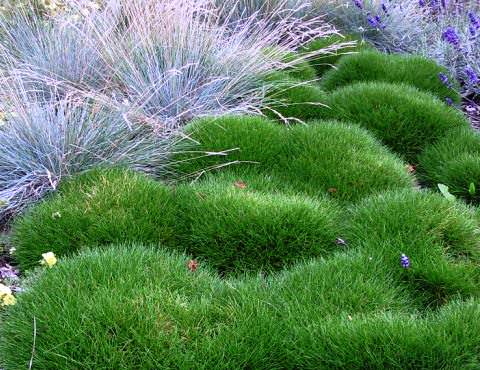

All garden plant species are frost-resistant and do not require winter shelter. Be careful - excessive moisture and stagnant water are detrimental to perennials and can lead to their death.
Caring for fescue during the season is reduced to periodically combing grass bunches to remove dry shoots and pruning peduncles after flowering.
When the bumps begin to bare, then it is time to rejuvenate the plant. It is the rapid degeneration of curtains that is the main disadvantage of this spectacular cereal. The center of the sod begins to become bare already 2-3 years after planting. However, this disadvantage is compensated for by the rapid growth of the grass, which creates beautiful compositions.
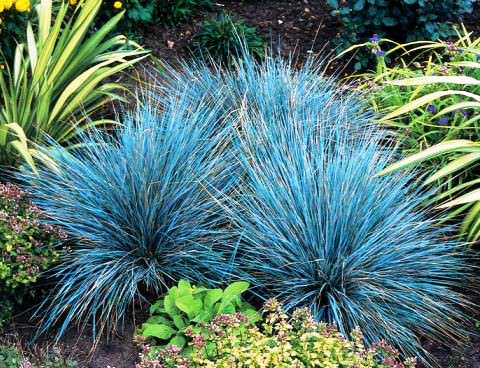

The rejuvenation procedure is carried out at the beginning of spring, dividing the bush into several parts, which are taken on the sides, and the dry center is thrown away. Delenki are planted in a permanent place. The propagation of the cereal is carried out in the same way. Can also be propagated using seeds. The grass gives good self-seeding, it is enough to dig out the grown seedlings and transplant to a permanent place.
Red fescue grass (with photo)
Red fescue herb (Festuca rubra) - a rhizome-loose shrub with creeping rhizomes forming rather dense turf. In terms of its biology and development, it is close to the meadow bluegrass. But there are also significant differences. Red fescue is less winter-hardy and frost-resistant, but more drought-resistant and shade-tolerant. In addition, it is more resistant to fungal diseases, drought. The leaf blade is 1-3 mm wide, bristle-shaped, rigid, distinctly embossed. The uvula is very short, truncated, difficult to distinguish.
Grain grass, has rhizome-loose forms. The most valuable are rhizomes. The rhizomes are short with numerous fibrous roots that go deep into the soil up to 125 cm. The bulk of the roots is located in the upper soil layer at a depth of 20 cm. Plants form loose tufts. Stems are cylindrical, thin, smooth, rough under the panicle, with raised bases, covered with reddish-brown sheaths. Inflorescence - panicle 6 to 15 cm long, spreading during flowering, compressed after flowering. The branches of the panicle are rough, one or two extending from the lower part of the main axis of the inflorescence. Spikelets are green or lilac, 4-9-flowered. Spikelet scales are lanceolate, sharp, rough in the upper part, of unequal length. The lower floral scales are narrow-lanceolate with weakly visible veins, glabrous or hairy, with a short awn. The fruit is a caryopsis, about 3 mm long. Red fescue is widespread in forest and forest-steppe zones. It grows in meadows, humid slopes, in forests, among shrubs, in sparse birch forests, in pine forests, on old fallow lands. The plant is winter-hardy, not drought-resistant and not salt-tolerant. In the spring it starts growing early, and in the fall, in a green state, it goes into winter. It is characterized by a slow rate of development, reaching full development in the third or fourth year. Keeps in herbage for over 10 years. Flooding tolerates up to 35 days, they respond well to weak siltation. Does not form flowering shoots in the year of sowing. During the years of use, it blooms in late May - early June. The seeds ripen in July. Red fescue was introduced into cultivation as a pasture plant. Red fescue grows well in culture on humus-rich loams, on developed marsh and wet soils. It is responsive to irrigation and is considered one of the best grasses for irrigated pastures. On moist sandy loam soils, forms a dense herbage. Forms a continuous sod with prolonged use. However, it was not widely spread in culture.
See what the red fescue grass looks like in the photo showing the flowering and ears of the cereal:
Diseases
For the lawn, red fescue is more suitable than any other representative of its kind. The bright green carpet is not only highly decorative, but also resistant to various kinds of diseases. But there are diseases that can affect the plant:
- Powdery mildew. If the grass is affected by this fungal disease, then the first sign will be the appearance of small spots, which will become larger over time and become purple in color. Spots may appear on both sides of the leaves. If the affected leaves are few, they must be removed. The bushes of plants must be treated with a solution of soda ash with the addition of soap or a manganese solution. It is recommended to spray the bushes of plants every week. For the prevention of the disease, it is necessary to spray the plants with special agents several times over the summer.
- Rust. This is a rather dangerous fungal disease for fescue grass. The disease can be identified by the presence of small orange or rusty spots on the leaves. As the grass grows, the spots gradually increase in size and lead the leaf to death. To change the situation and save the plant from this scourge, you first need to remove the affected leaves, and then treat all the bushes with special means.
This lawn grass is very rarely affected by harmful microorganisms.If it can be struck by diseases that even a novice gardener can easily cope with, then pests do not threaten fescue at all.
Meadow fescue grass: description and photo
Meadow fescue grass (Festuca pratensis) looks like a bonfire at first glance. They differ in inflorescences: by the fire it is soft and always spreading, and in fescue it is hard, and it becomes loose only during flowering, before flowering and after the panicle of fescue is compressed. The panicles of meadow fescue contain 5–10 long yellowish-greenish or purple spikelets. Spikelets are lanceolate, 4–9-flowered, on clearly visible legs of various lengths, cylindrical, laterally compressed. Flowers without awns. Lower branches one or two, a long branch with 4–5, short with 1–2 spikelets.
It is possible to begin the description of meadow fescue with the fact that it is a middle-summer high-rise loose-shrub grass of the winter type of development. The main mass of fibrous roots is located at a depth of 25 cm. The stems are smooth, cylindrical, rising at the base, from 60 to 120 cm high. There are many stems in the bush, the foliage is good. Leaves are linear, soft, up to 5 mm wide, slightly rough along the edges, shiny, bright green on the underside of the plate. Lingula up to 1 mm long. The fruit is an oblong weevil, brownish in color with a clearly visible embryo. Seeds are fluid, large. Meadow fescue is widespread in forest and forest-steppe zones. It grows in damp meadows, less often in dry meadows. Prefers rich, loamy, moderately moist soils. It is less widespread on sandy and sandy soils. Grows well in floodplain meadows, where it achieves a large participation in herbage. It develops poorly on acidic soils.
It blooms in the second half of June, the seeds ripen at the end of July. It grows back early in the spring, but then develops slowly. It is characterized by an average rate of development. Forms vegetative shoots until late autumn. In the year of sowing, it gives only vegetative mass and many non-flowering, but well leafy stems. Reaches full development in the second or third year. It is a mid-summer plant, often in grass stands for 7–8 years. Medium-ripening cereal. A moisture-loving plant, mesophyte, reacts negatively to drought. Flooding with hollow waters takes 20-25 days. It responds well to irrigation. It is considered one of the best grasses for irrigated meadows. Hardy, tolerates late spring frosts well. Prone to lodging. In terms of chemical composition and digestibility, it belongs to the best cereals, in terms of eatability - to absolute, and in terms of productivity - to higher average. Widely introduced into the culture.
See how meadow fescue is different - the photo of the plant shows the characteristic features of this type of cereal:
How to properly care for fescue
Lawn grass Lilliput: description, composition and characteristics
Lawn grass fescue adapts well to any conditions and is rather picky. For healthier, stronger plants, choose well-lit planting areas. Any soil is suitable, but if you want to see a thick cover of healthy cereals on the lawn, then it is better to prepare fertile loose soil for planting. The plant is great to tolerate drought, but to get more spiky shoots, you need to water regularly. Mulching the soil will have a positive effect on the cultivation of full-fledged plants. For this, the ground in the lawn is lined with decorative stones - it will be difficult for weeds to grow among the stones, and moisture will evaporate very slowly.
Note! It is recommended to plant fescue three years after planting.
When the panicles grow in the plant, it is recommended to remove them, otherwise the stems are severely depleted, and the grass becomes weak. Removal can be combined with mowing the lawn.


Watering the fescue
Fescue grass is a winter-hardy plant, so it is not necessary to cover it for wintering.With the onset of spring, you can clean the lawn. For this, dried weeds and dry fallen leaves are carefully removed with a rake.
Hondo fescue (Festuca hondoensis)
In Russia hondo fescue (Festuca hondoensis) found only in the Sakhalin region, where it is known only from the island of Shikotan (northern border of the species range). Outside of the Russian Federation, it is common in Japan. It grows on rocky slopes, open rubble tops of small hills and on seaside rocks.
A perennial plant, forms dense tufts with predominantly intravaginal shoots. Stems 30-50 cm tall, thin, smooth. Sheaths of inner leaves of vegetative shoots - accrete for 1/2 of their length. Leaf blades up to 0.5 mm in diameter, elongated, hair-like, soft, smooth outside. Panicles 6-8 cm long, friable, lilac-colored. Spikelets are 4.7-5.2 mm long, with 4-6 flowers. Blossoms in July; bears fruit in August.
See how fescue is used - the video shows the options for sowing on a personal plot:
Pole grass
It has rather long ground shoots, rooting at the nodes, after which daughter plants grow. Has a dense and uniform grass stand, suitable for low cutting. Good resilience makes this variety suitable for golf courses, but also suitable for expensive ornamental lawns. The softness of the grass and the density of the grass make it popular for use on home lawns as well.
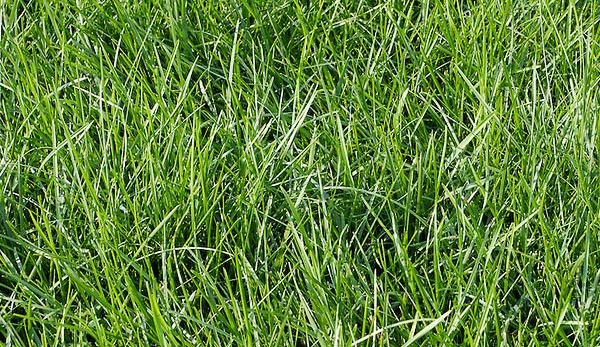

Festullolium
- It is a plant obtained through a long selection process involving perennial ryegrass and reed fescue. It has sprawling bushes with 34 stems.
- After mowing, it has an even and dense grass stand.
- It is one of the most important sod formers for rough lawns, slopes along roads. Also used in soil reclamation.
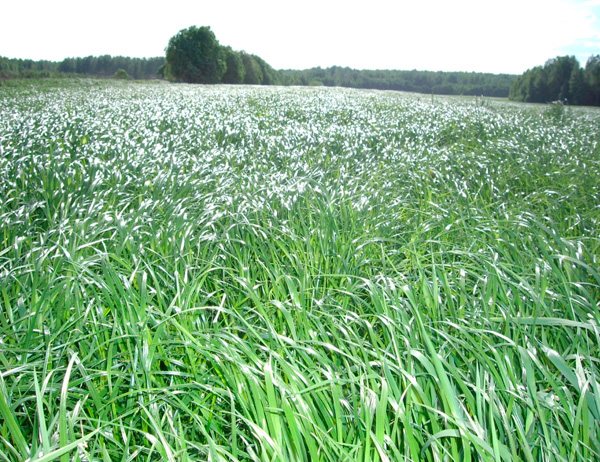

Culture properties
The main purpose of the plant is decorative properties that are suitable for decorating any garden. It is very simple to grow fescue; this activity will not cause unnecessary problems even for the most inexperienced summer resident.
Growing fescue is easy
The plant is unpretentious, perfectly tolerates attacks of diseases and pests, is resistant to sudden changes in weather conditions, so it is very easy to care for it.
Important! The plant is quite supportive of all types of soil, so it can be planted almost anywhere.
The main disadvantages of fescue are poor frost resistance, as well as shaded and swampy areas of household plots. Fescue requires constant division, because it is much more difficult to care for a huge plant.
Care secrets
Blue fescue seeds take root very quickly, and after germination they require the same care as the lawn. It is necessary to monitor soil moisture, fertilize as needed, and divide the plants every two or three years. It is necessary to plant so that the plants do not get used to the soil and do not die off.
After the winter period, it is required to remove old dead leaves.
To get the largest increase in ornamental grass, it is worth propagating it through planting, and not through seeds. And it is also possible, when planting from seeds, to germinate them first. To do this, they are planted in a box at the beginning of March and kept at room temperature.
Pay particular attention to watering, you can not overmoisten the plant. Therefore, consider weather conditions, soil type and moisture level.
With proper care, blue fescue panicle inflorescences will adorn your backyard for a long time.
Cocksfoot
- The plant loves loamy, clayey or humus soils with moderate moisture. Light soil does not tolerate well. It is resistant to shade and drought, but it does not tolerate cold and excess moisture.
- This species is used as a monoculture, it releases toxic substances into the ground that inhibit the development of other species. As a result, the plants begin to fall out of the grass stand, and the hedgehog transforms into a hummock.
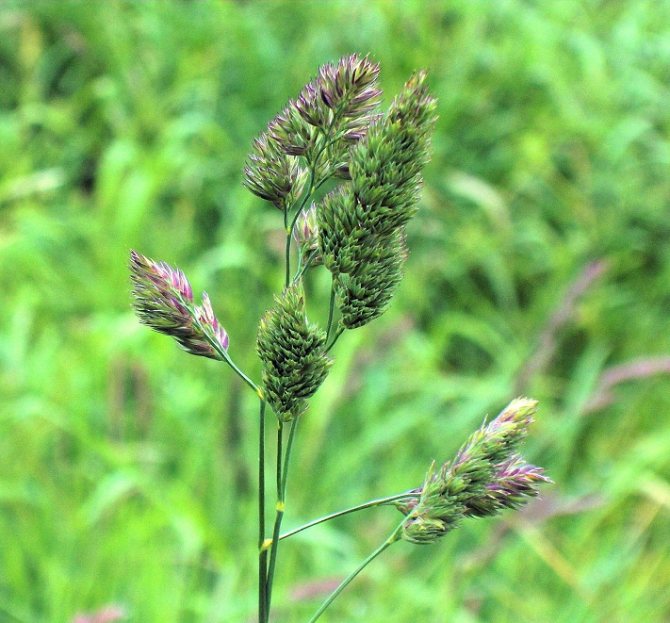

Comfortable conditions for fescue
Blue fescue is a member of a wide family of ornamental grains. Refers to the kind of sun lovers. To succeed in growing, you need to find the warmest or even hottest spot in your garden. Even the most intensely lit south sides will do well. If you plant fescue in a too dark place, then you will not get a bluish shade of the sheets.
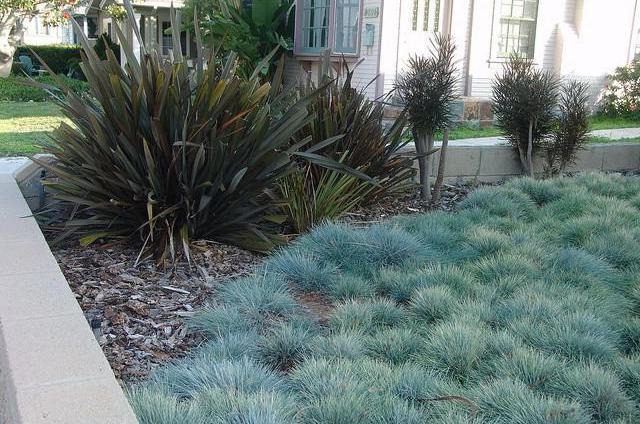

These plants do not put forward special requirements for the soil, so that even in completely dry zones, their spherical shape will decorate the site. You should not choose an area where moisture can accumulate, they do not like the described plants and highly nutritious soils. It is believed that the most beautiful fescue grow on the rocky soil of rock gardens and rockeries.
All species of this plant are frost-resistant and therefore do not need protection in winter. But it is still worth purchasing varieties already acclimatized to your climatic zone.
They also have a drawback - the rather rapid extinction of curtains. After 2-3 years, the center of the sod gradually dries out in the plant, so they need to be constantly rejuvenated and separated.
Fescue is especially strong in width, and not in height, so it will fill the required area well.
Bent bent
It has loose and dense bushes, a perennial variety that grows on poor oxidized soil. Usually found in highlands and semi-shaded areas. Provided the plant is well nourished and regularly watered, it can withstand a short cut.
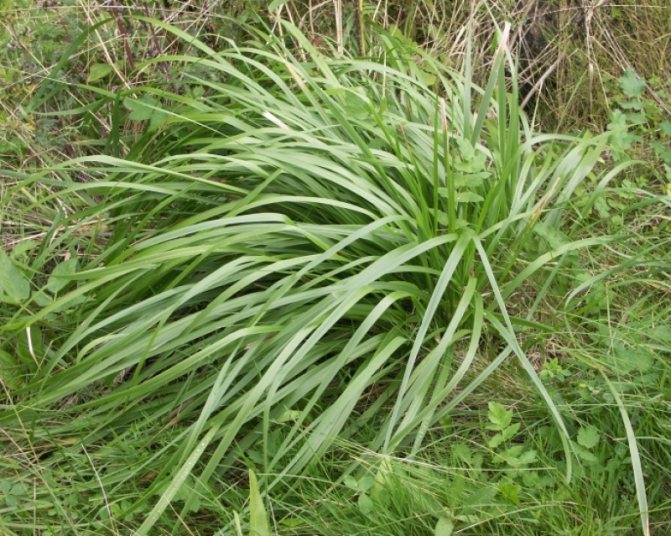

Usually adjoins red fescue in grass mixtures. It is used in decorative grass mixtures for golf courses.
Reproduction methods
Fescue is propagated by seeds and by dividing the bush. Seed propagation often takes place by self-seeding. If the grass is not cut off in a timely manner, then the mature seeds spill out of the ears on their own onto the ground. Young shoots appear in the spring. After a month, they can be transplanted to a permanent place. If this cereal is not yet found on the site, then the purchased seeds are sown at the end of February in containers for growing seedlings. Before planting, the seed is soaked in a weak solution of potassium permanganate. Crops are grown densely to obtain a dense cushion. To do this, 5-7 seeds are placed at a time in holes with a distance of 10-20 cm, to a depth of 5 cm. After 1.5-2 weeks, the first shoots will appear. They develop very quickly and soon a dense sod is formed, ready for transplanting into open ground. It is important to keep the seedlings in a cool and well-lit place to prevent the stems from stretching too far.


A well-grown bush 2-3 years old can be divided into parts. The procedure is carried out in April or September. The sod is completely dug up and divided into several small parts, being careful not to damage the roots. Plants are immediately planted in renewed soil with the addition of compost or humus. Such divisions take time to grow again. You can speed up the process if for the winter a large bush is transplanted into a flowerpot and brought into a cool and well-lit room. They make sure that there is no dampness in the wintering place. In March, the mother plant is divided into parts and planted in containers with prepared soil.

